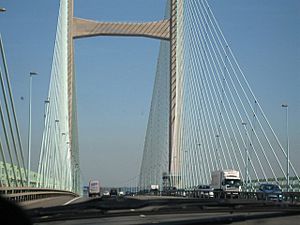Cable-stayed bridge facts for kids
A cable-stayed bridge is a special kind of bridge. It uses tall columns, often called towers or pylons. Strong cables connect directly from these towers to the bridge deck, which is the part you drive or walk on. These cables help hold up the road, making the bridge very strong.
- Difference between types of bridges
Contents
Types of Cable-Stayed Bridges
There are two main ways cable-stayed bridges are designed. These designs change how the cables are attached to the towers.
Harp Design Bridges
How Harp Bridges Work
In the harp design, the cables look a bit like the strings of a harp. They are almost parallel to each other. This happens because each cable connects to a different spot on the tower. The higher a cable connects on the tower, the further away it connects to the bridge deck.
Fan Design Bridges
How Fan Bridges Work
The fan design is different. Here, all the cables meet at or near the very top of the tower. They spread out downwards to connect to different points on the bridge deck, like an open fan.
Why We Build Cable-Stayed Bridges
Cable-stayed bridges are chosen for specific reasons. They are great for spans that are longer than what a cantilever bridge can easily cover. However, they are usually for shorter distances than what a huge suspension bridge needs.
Comparing Bridge Types
Cable-Stayed vs. Cantilever Bridges
Cantilever bridges can become too heavy if they are built for very long distances. Cable-stayed bridges can cover these longer spans without being too heavy.
Cable-Stayed vs. Suspension Bridges
For shorter distances, a cable-stayed bridge is often cheaper to build than a suspension bridge. Suspension bridges need very large anchor points on the ground, which can be expensive.
Good Things About Cable-Stayed Bridges
- They are very stiff and strong.
- They don't need huge ground anchors like some other bridges.
- They often look very modern and impressive.
- They can be a good choice for building costs.
- Their design is usually well-balanced.
Things to Consider About Cable-Stayed Bridges
- They can sometimes sway a bit in strong winds.
- Their main support towers are often built in water, which can be a challenge.
Images for kids
-
The Øresund Bridge connects Malmö in Sweden to Copenhagen in Denmark.
-
An early chain-stayed bridge design by Fausto Veranzio from the 1500s. Before steel cables, bridges used linked rods or chains.
-
The Prins Clausbrug crosses the Amsterdam-Rhine Canal in Utrecht.
-
The Puente de la Unidad connects San Pedro Garza García and Monterrey.
-
The Zhivopisny Bridge in Moscow has a unique multiple-span design.
-
The Erasmus Bridge, Erasmusbrug, in Rotterdam, Netherlands.
-
The Margaret Hunt Hill Bridge over the Trinity River in Dallas, Texas, U.S. (2012).
-
The Rio Negro Bridge, at 3,595 metres (11,795 ft), is the longest cable-stayed bridge in Brazil.
See also
 In Spanish: Puente atirantado para niños
In Spanish: Puente atirantado para niños














